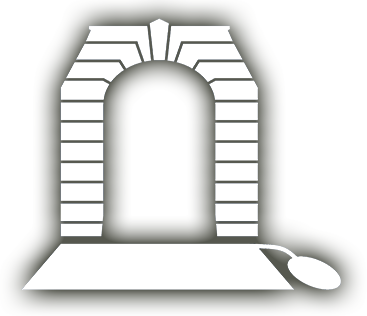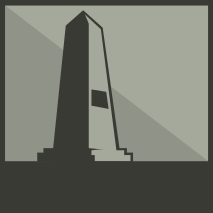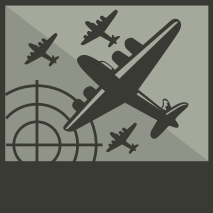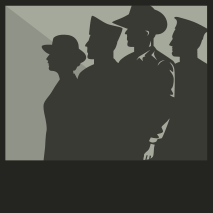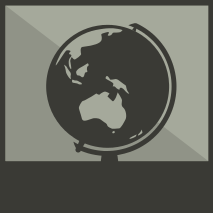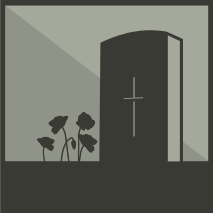
About This Unit

The unit colour patches were part of a complex heraldic system that explained in large part the connectivity of the units of the First AIF. In this case, the rectangle signifies the First Division. The pale blue lower bar signifies the third brigade in the division. The brown upper bar denotes the third battalion of the brigade.
On August 4 1914 Great Britain declared war on Germany. Australia quickly followed the Mother Land’s call to arms. A rush of volunteers flocked to Blackboy Hill Camp near Perth and the 11th Battalion became the WA contribution to the 3rd Brigade in the 1st Division. The Third Brigade comprised Battalions from the smaller States.
From the city and suburbs clerks laid down their pens, shopkeepers and shop assistants walked out of their shops, solicitors paused with their briefs, workmen downed their picks and shovels and from the countryside bushmen, farmers, graziers, shearers, woodchoppers set out on by horse drawn buggy, by train, by horse and on foot starting their journey to join a new type of army - an all volunteer army - the Australian Imperial Force.
They were assembed equipped and trained (many had served in the militia so army drill, shooting and field exercises were not new to them) and by late October the Great Convoy began assembling in ports around the country departing over the period 15-25 October 1914. The 11th Battalion left direct from Fremantle (along with ships carrying the 10th Battalion) joining the rest of the convoy and escorts which had assembled at Albany, at sea, before crossing the Indian Ocean for the Middle East.
Like its sister Battalions in the 3rd Brigade, the 11th Battalion would go on to make history at Gallipoli as part of the Covering Force - the first ashore. The 11th Battalion landed at Anzac on 25th April 1915, led by Lieutenant Colonel James Johnston, the officer who had raised the battalion. Ten days after the landing, a company from the 11th Battalion mounted the AIF's first raid of the war against Turkish positions at Gaba Tepe, led by the redoubtable Major Raymond Leane who subsequently commanded the 11th and 48th Battalions.
Subsequently, the battalion was heavily involved in defending the front line of the ANZAC beachhead. In August, it made preparatory attacks at the southern end of the ANZAC position before the battle of Lone Pine. The battalion served served throughout the campaign at ANZAC until the evacuation in December.
Following extraction to Egypt, it was split along with all of the Battalions in the 1st-4th Brigades to create the new Battalions of the 4th and 5th Divisions. The 11th Battalion's 'pup' Battalion became the 51st Battalion in the 13th Brigade in the 4th Division.
In March 1916, the newly 'doubled' AIF began sailing for France and the Western Front.
From then until 1918 the battalion was heavily involved in operations against the German Army. The battalion's first major action in France was at Pozieres in the Somme valley in July 1916. After Pozieres / Mouquet Farm, the battalion fought at Bullecourt in the bloody Second battle in May 1917, and then to Ypres in Flanders for the great offensive which while initially successful, with victories in which the Battalion was involved at Menin Road and Broodseinde Ridge, the offensive was ultimately foiled by the onset of torrential rain and the mud and misery of Passchendaele. The 11th Battalion sat out the winter in Flanders.
1917 began with a German consolidation of their Front Line and an orderly withdrawal through what were called 'The Outpost Villages' through which they conducted a delaying defence. The AIF was tasked to follow this up and a series of engagements ensued, culminating in April with the first of two attacks on Bullecourt. First Bullecourt was an exclusively 4th Division attack which although successful in breaking in to the German line was not adequately supported and it subsequently failed. Second Bullecourt followed in May and involved the 1st 2nd and 5th Divisions. Tactically it was very similar to First Bullecourt with a break-in being achieved, the tanks failing - again - and inadquate artillerry support because of difficulties getting the guns far enough forward. From a caualty perspective, it was Pozieres all over again.
The 1st Division was reconstituted and reinforced during the period May -end July, when all of the AIF (for the first time including the 3rd Division) was committed to the Third Ypres campaign. The 1st Division was committed to fighting at Menin Road inlate September 1917 and at Broodseinde Ridge on 4th October. The Third Ypres campaign bogged down in misery of 1st and 2nd Passchendaele in late October and November.
The Battalion helped to repel the German Spring Offensive in March - April 1918 in Flanders. The AIF had been sent south to bolster the British 5th Army which was crumbling io front of the German onslaught. Then it was realised that an attack was to be made in Flanders towards the rail head of Hazebrouk, so the 1st Division rushed back to be told by British General Harrington CoS British 2nd Army, on arrival at Hazebrouk station, that they (the 1st Division) were the only formed body of troops between here and the Channel Ports (Calais and Bolougne). They became a rallying point around which other troops copnsolidated. and the Operation Georgette attacks were blunted. As a result, the Battle Honours Lys Hazebrouck and Kemmel were awarded.
The 1st Division started the Amiens offensive in reserve but was later committed to the left flank along the Somme, taking part in actions around Chipilly and Chuignes across the Somme towards Bapaume securing the right flank of the British Army while it advanced on Bapaume. It also allowed the 3rd Australian Division to cross the Somme and secure the Australian Corps northern flank for the attack on Mont St Quentin.
The First Division finished its last phase of combat operations in the vicinity of Epehy on the approaches to the Hindenburg Line. After the 2nd Division attack on the Beaurevoir Line at Montbrehain on the 5th October, the AIF was withdrawn from the line to reinforce and refit following the accumulated losses it had sustained since 8th August.
The Battalion along with the rest of the AIF, was resting 'out of the line' when the Armistice was declared on the 11th November 1918. The long process of repatriation and demobilisation began. For rmany, re-settling into civilian life after the turmoil of the battlefield was not a straightforward process.
Many were beset with the legacy of multiple woundings, in some casess amputations, gassing and what we now know as PTSD. Many died young, it is a staggering staistic but 50% of the men who returned from the war were dead from multiple causes within 20 years, no doubt exacerbated by the onset of the Great Depression. The effects of the war did not discriminate by rank or station in life. Others lived on to lead very productive lives rendering further service to the community, marching every Anzac Day in memory of their fallen mates until they too succumbed to the passage of time. They had lived through 'The Broken Years', so vividly described in Professor Bill Gammage's superb book of the same name.
Members of the Battalion eceived the following awards during the course of the war: 1 VC; 1 CB; 2 CMG; 7 DSO; 1 OBE; 30 MC, 1 bar; 25 DCM, 1 bar; 96 MM, 2 bars; 3 MSM; 85 MID; 7 foreign awards
Battle/ Campaign/ Involvement
ANZAC / Gallipoli (/explore/campaigns/1) - 25 April 1915 to 19 December 1915
Lone Pine (/explore/campaigns/3) / Sari Bair / Suvla - 6th August 1915
Pozières (/explore/campaigns/5) - 23 July 1916 to 4 September 1916
Mouquet Farm (/explore/campaigns/103) - 8 August 1916 to 5 September 1916
Second Bullecourt (/explore/campaigns/6)- 3 May 1917 to 17 May 1917
Menin Road (/explore/campaigns/26) - 20 September 1917 to 25 September 1917
Broodseinde (/explore/campaigns/18)- 4 October 1917 to 5 October 1917
Poelcapelle - 9 October 1917
2nd Passchendaele (/explore/campaigns/29) - 26 October - 10 November 1917
Hazebrouck (/explore/campaigns/80)-12 April 1918 to 15 April 1918
Amiens (/explore/campaigns/14)- 8 August 1918 to 11 August 1918
Albert 1918 - (incl Chuignes) 21 August 1918 to 23 August 1918
Epehy - 2 October 1918 to 5 October 1918
Generic Battle Honours included :
ANZAC 1915
Gallipoli 1915
Defence of Anzac 1915
Egypt 1915-16
France and Flanders 1916-18
Somme 1916-18
Ypres 1917 (/explore/campaigns/8)
Compiled by Steve Larkins Apr 2013 updated Dec 2020
We would particularly like to encourage individual historians researchers or members of unit associations to contribute to the development of a more detailed history and photographs pertaining to this unit and its members.
Please contact [email protected] (mailto:[email protected]) for details on how to contribute.
Stories
The ANZAC 'A' insignia
Members of the Australian Imperial Force who served on Gallipoli will be entitled to wear over the Unit “Colour Patch” on both sleeves of the Service Dress Jacket and Greatcoat the letter “A” an indication that the wearer had taken part in the operations on the Gallipoli Peninsula. - Military Order 354 of 1917
Members of the Australian Imperial Force who served on Gallipoli or the Islands of Lemnos, Imbros and Tenedos, or who have served on transports or hospital ships at or off Gallipoli or the Islands above-named, or in AIF lines of communication Units in Egypt will be entitled to wear over their Unit “Colour Patches” on both sleeves of their Service Dress Jacket and Greatcoat the letter “A” as an indication that the wearer had taken part in the Gallipoli operations. - Military Order 20 of 1918
Robert Kearney
Submitted 3 July 2019 by Virtual Australia

